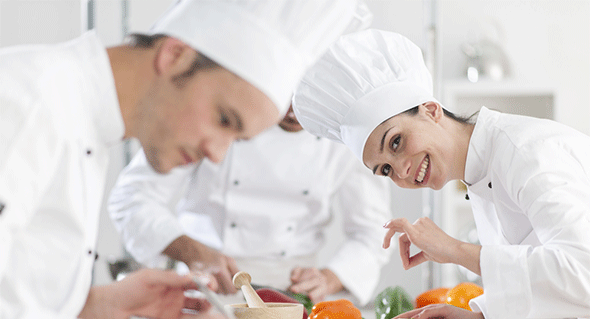 I was once working in an upscale hotel kitchen, and they required all their kitchen staff to wear tall chef hats while on shift. Though tall chef hats can appear very impressive, they were not very practical. Every time I opened the door to one of the walk-in fridges, my hat would be blown off by the powerful fans. On the other hand, in culinary school we wore baseball caps as cooking hats. The advantage was a more comfortable to work with fit, but the main disadvantage was that the visor would sometimes get in the way of seeing everything that was going on around me in the kitchen.
I was once working in an upscale hotel kitchen, and they required all their kitchen staff to wear tall chef hats while on shift. Though tall chef hats can appear very impressive, they were not very practical. Every time I opened the door to one of the walk-in fridges, my hat would be blown off by the powerful fans. On the other hand, in culinary school we wore baseball caps as cooking hats. The advantage was a more comfortable to work with fit, but the main disadvantage was that the visor would sometimes get in the way of seeing everything that was going on around me in the kitchen.
The decision of which chef hat to require workers to wear should be a balance between utility and aesthetics. On the one hand, it should be comfortable for workers to do their day to day tasks, while not having to worry about their hair getting into the food. On the other hand, customers are likely to glimpse the chefs, making it important to have some kind of uniformity and aesthetic look to the chef hats. Chef hats are usually required according to food business regulations, so choosing the right ones is very important. This guide provides an overview of a few of the options often used.
Toque Hats
Toque hats are the most often used, and most common hats that come to mind when thinking of chef hats. Toque hats are usually made of disposable paper and white, and are tall and stiff. In short, that inconvenient hat I wrote about in the first paragraph of this article: that was a tall toque hat. Toque hats can come in two difference forms, with one type being tall and stiff and the other more floppy. The tall and stiff ones are offered in different heights and sizes, and offering a few different types in a venue can
enable chefs to choose the most impressive ones when meeting with customers, while choosing shorter, more convenient ones when working in the kitchen.
Beanies
Beanies are tight-fitting caps that usually come in a variety of sizes and colors, providing the option for each employee to choose a cap according to their preferences. Though beanies are less attractive than toque hats, they can provide a more comfortable alternative. One of the major downsides of beanie hats, however, is that they can make the wearer’s head hot and sweaty during service. Beanies styles with mesh attempt to solve this drawback.
Bandannas and Baseball caps
Bandannas and baseball caps are adequate chefs hat option in that their size can usually be easily adjusted. Bandannas are usually made of cotton and allow a comfortable and breathable feel. However, they can sometimes slip, making them a potential hazard in the kitchen. Baseball caps, as I mentioned above, can limit visibility in the kitchen, which can be distracting as well as a potential safety hazard.
Mesh Caps
Mesh caps are often seen used in supermarkets and school cafeterias. They are those shower-cap-like hats that are not very aesthetic. This type of chef hat is not usually adopted in restaurants and hotels, as it is not necessarily the most convenient option, and is by no means the most attractive option. The advantage is in the low price.
Chef hats are very important for every food preparation business in order to help ensure that employees’ hair stays out of the food. However, the wrong chef hat can make a bad impression on customers, or worse, be uncomfortable and inconvenient for work in the kitchen. Many different adequate options exist, but what might work for one employee may be uncomfortable for another, making adaptability and options of sizes and styles a key factor to consider. Toque hats will always be the number one chef hat, but it might not necessarily be the best option in every situation.